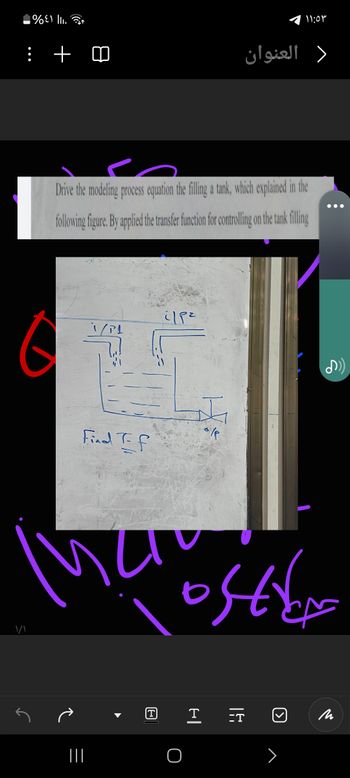
Elements Of Electromagnetics
7th Edition
ISBN: 9780190698614
Author: Sadiku, Matthew N. O.
Publisher: Oxford University Press
expand_more
expand_more
format_list_bulleted
Question

Transcribed Image Text:% 11.
+
11:04
) العنوان
Drive the modeling process equation the filling a tank, which explained in the
following figure. By applied the transfer function for controlling on the tank filling
1/P1
۱/۱
Find I-f
inc
ostron
|||
A
O
I =T
☑
M
Expert Solution
This question has been solved!
Explore an expertly crafted, step-by-step solution for a thorough understanding of key concepts.
Step by stepSolved in 2 steps with 2 images

Knowledge Booster
Similar questions
- Please show stepsarrow_forward'p' (liquid density 'A' (tank cross sectional area) 'Qin' (Input Flow Rate) "Que P 'R' (restriction coefficient) '' (head of liquid) dh Qin = A + dt Figure 1 The single tank system (Figure 1) has been modelled by the first order differential equation given as equation. The equation describes the relationship between the input flow rate entering the tank and the head of liquid in the tank. ph R 5 m equation The following constants are provided: R = 40 Kpa s m², 4 = 10 m², p= 1001 kg m², and g = 9.81 m s A pump is suddenly switched on and provides a step input flow rate of 0.5 m³s¹. (1) Using Laplace Transforms, solve equation and provide an expression to show how the level in the tank will vary in time after the step input has been applied.arrow_forwardhey can i get help with these two questions please. thank you.arrow_forward
- ZVA @ e SIM a A moodle1.du.edu.om Solve the second order homogeneous differential equation y " -6y'-7y = 0 with intial values y(0) = 0; y'(0) = 1 %3D Maximum file size: 200MB, maximum number of files: 1 Files IIarrow_forwardPlease solve this question in mechatronicsarrow_forwardb. Using Simulink, simulate the transfer function airflow response, Q(t) (air entering respiratory system) for a sine wave input pressure Pao(t)= 2.5 cm·H2O (i.e. 5 cm·H2O peak-to-peak) at 15 breaths min' (or 0.25 Hz) for each lung model. Use the following parameters: -1 i. RC model: R= 1cm·H2O's L' and C=0.2 L·cm·H2O¯ RIC model: R= 1cm·H2O's·L', C= 0.2 L·cm·H2O¯ , and I= 0.01 cm·H2O L-s² Two-compartment model: R. = lcm H2O's L', Rp1,2 = 0.5 cm·H2O•s·L', Cp1,2=0.2 L·cm·H2O', and I= 0.01 cm H2O·L-•s² Mead model: R. = 1cm·H2O•s L', Rp = 0.5 cm:H2O•s·L', C1 =0.2 L·cm·H2O', Cw=0.2 L·cm·H2O-', C, =0.005 L·cm·H2O', and I= 0.01 cm H2O·L-1·s² ii. iii. iv.arrow_forward
- The Johnson & Royce model of a distillation column is driven by the inputs of steam flow and its flow rate; the output measurement is the temperature change. The state-space model is given by: -2 x = [¯²¯¯¯7 | x + | | | u; y = [0_1]x - the system defining the model of the distillation column is a. Asymptotically stable O b. Unstable Oc. Marginally stable Od. Indeterminate in relation to its stabilityarrow_forwardFind the local maximum and minimum values and saddle point(s) of the function. You are encouraged to use a calculator or computer to graph the function with a domain and viewpoint that reveals all the important aspects of the function. (Enter your answers as comma-separated lists. If an answer does not exist, enter DNE.) f(x, y) = 9 sin(x) sin(y), −? < x < ?, −? < y < ? local maximum value(s) local minimum value(s) saddle point(s) (x, y) =arrow_forwardB9arrow_forward
- find trasfer function Y(s)/R(s) if kc is 5 and plant is 1/(0.5s+1). input r(t) is a unit-step functionarrow_forwardHelp me with this ASAP. Thank you! Find the Following: 1. Natural angular velocity 2.Damped angular velocity 3. Equation of motion x(t). Assume Initial conditions for displacement and velocity 4. Graph 2 cycles of the vibrating system. You can use third party app for this.arrow_forwardCan anybody help me, the underlying reason behind the equations of teta 1 up until 6. These equations should be the representation of inverse matrix of 6R Manipulatorsarrow_forward
arrow_back_ios
SEE MORE QUESTIONS
arrow_forward_ios
Recommended textbooks for you
 Elements Of ElectromagneticsMechanical EngineeringISBN:9780190698614Author:Sadiku, Matthew N. O.Publisher:Oxford University Press
Elements Of ElectromagneticsMechanical EngineeringISBN:9780190698614Author:Sadiku, Matthew N. O.Publisher:Oxford University Press Mechanics of Materials (10th Edition)Mechanical EngineeringISBN:9780134319650Author:Russell C. HibbelerPublisher:PEARSON
Mechanics of Materials (10th Edition)Mechanical EngineeringISBN:9780134319650Author:Russell C. HibbelerPublisher:PEARSON Thermodynamics: An Engineering ApproachMechanical EngineeringISBN:9781259822674Author:Yunus A. Cengel Dr., Michael A. BolesPublisher:McGraw-Hill Education
Thermodynamics: An Engineering ApproachMechanical EngineeringISBN:9781259822674Author:Yunus A. Cengel Dr., Michael A. BolesPublisher:McGraw-Hill Education Control Systems EngineeringMechanical EngineeringISBN:9781118170519Author:Norman S. NisePublisher:WILEY
Control Systems EngineeringMechanical EngineeringISBN:9781118170519Author:Norman S. NisePublisher:WILEY Mechanics of Materials (MindTap Course List)Mechanical EngineeringISBN:9781337093347Author:Barry J. Goodno, James M. GerePublisher:Cengage Learning
Mechanics of Materials (MindTap Course List)Mechanical EngineeringISBN:9781337093347Author:Barry J. Goodno, James M. GerePublisher:Cengage Learning Engineering Mechanics: StaticsMechanical EngineeringISBN:9781118807330Author:James L. Meriam, L. G. Kraige, J. N. BoltonPublisher:WILEY
Engineering Mechanics: StaticsMechanical EngineeringISBN:9781118807330Author:James L. Meriam, L. G. Kraige, J. N. BoltonPublisher:WILEY

Elements Of Electromagnetics
Mechanical Engineering
ISBN:9780190698614
Author:Sadiku, Matthew N. O.
Publisher:Oxford University Press

Mechanics of Materials (10th Edition)
Mechanical Engineering
ISBN:9780134319650
Author:Russell C. Hibbeler
Publisher:PEARSON

Thermodynamics: An Engineering Approach
Mechanical Engineering
ISBN:9781259822674
Author:Yunus A. Cengel Dr., Michael A. Boles
Publisher:McGraw-Hill Education

Control Systems Engineering
Mechanical Engineering
ISBN:9781118170519
Author:Norman S. Nise
Publisher:WILEY

Mechanics of Materials (MindTap Course List)
Mechanical Engineering
ISBN:9781337093347
Author:Barry J. Goodno, James M. Gere
Publisher:Cengage Learning

Engineering Mechanics: Statics
Mechanical Engineering
ISBN:9781118807330
Author:James L. Meriam, L. G. Kraige, J. N. Bolton
Publisher:WILEY